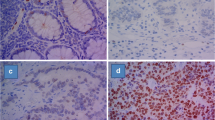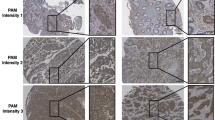Abstract
HoxB13 is a transcription factor involved in defining of posterior endodermal derivatives, including prostate and rectum. While it is used as a marker of prostatic adenocarcinoma, it has not been studied systematically in neuroendocrine neoplasms. Thus, we performed HoxB13 immunohistochemistry in tissue microarrays and the whole sections of 232 neuroendocrine neoplasms. These included 34 paragangliomas (PGs), 20 cauda equina neuroendocrine tumors (CENETs), 123 well-differentiated neuroendocrine tumors (WDNETs), and 55 neuroendocrine carcinomas (NECs). WDNETs were additionally analyzed with SATB2, and colorectal WDNETs with CDX2 and serotonin immunohistochemistry. In total, HoxB13 immunoreactivity was observed in 95% (19/20) CENETs, 10.6% (13/123) WDNETs, and 12.9% (7/54) NECs. No PGs were positive. Large intestine WDNETs expressed HoxB13 in 68.4% (13/19); five negative tumors originated in cecum and one in rectum. In rectum, 92.9% (13/14) WDNETs expressed HoxB13. HoxB13 was 92.9% sensitive and 100% specific, showing 100% positive predictive value for the rectal origin of WDNET. In NECs, HoxB13 was positive in 15.4% (2/13) GIT tumors and 80% (4/5) prostatic NECs, but in none of urinary bladder NECs (0/8). SATB2 was positive in 17.1% (21/123) WDNETs, including 78.9% (15/19) of colorectal WDNETs, 71.4% (5/7) appendiceal WDNETs, and 2.9% (1/34) small intestine WDNETs. All 4 SATB2-negative large bowel tumors originated in the cecum. When both markers combined, HoxB13+/SATB2+ immunoprofile was seen exclusively in rectal WDNETs (positive predictive value 100%), while HoxB13−/SATB2+ immunoprofile was highly suggestive of the appendiceal origin (positive predictive value 71.4%). Therefore, HoxB13 can be useful as an immunohistochemical marker of rectal WDNETs and prostatic NECs.






Similar content being viewed by others
Data Availability
The results of immunohistochemistry of individual tumors together with the clinical data and histology images (in the form of “*.svs” formatted image files) used and analyzed during the current study are available from the corresponding author on reasonable request. The results of immunohistochemistry of all analyzed colorectal tumors are included as Supplementary Table 1.
References
Rindi G, Wiedenmann B Neuroendocrine neoplasms of the gut and pancreas: new insights. Nat Rev Endocrinol 8: 54-64, 2011.
Kojima M, Ikeda K, Saito Net al. Neuroendocrine Tumors of the Large Intestine: Clinicopathological Features and Predictive Factors of Lymph Node Metastasis. Front Oncol 6: 173, 2016.
Bellizzi AM SATB2 in neuroendocrine neoplasms: strong expression is restricted to well-differentiated tumours of lower gastrointestinal tract origin and is most frequent in Merkel cell carcinoma among poorly differentiated carcinomas. Histopathology 76: 251–264, 2020.
Lin X, Saad RS, Luckasevic TM, Silverman JF, Liu Y Diagnostic value of CDX-2 and TTF-1 expressions in separating metastatic neuroendocrine neoplasms of unknown origin. Appl Immunohistochem Mol Morphol 15: 407-414, 2007.
Soukup J, Manethova M, Faistova Het al. Pitx2 is a useful marker of midgut-derived neuroendocrine tumours - an immunohistochemical study of 224 cases. Histopathology 81: 799-807, 2022.
Tseng IC, Yeh MM, Yang CY, Jeng YM NKX6-1 Is a Novel Immunohistochemical Marker for Pancreatic and Duodenal Neuroendocrine Tumors. Am J Surg Pathol 39: 850-857, 2015.
Zhao LH, Chen C, Mao CYet al. Value of SATB2, ISL1, and TTF1 to differentiate rectal from other gastrointestinal and lung well-differentiated neuroendocrine tumors. Pathol Res Pract 215: 152448, 2019.
Bellizzi AM Immunohistochemistry in the diagnosis and classification of neuroendocrine neoplasms: what can brown do for you? Hum Pathol 96: 8–33, 2020.
Brechka H, Bhanvadia RR, VanOpstall C, Vander Griend DJ HOXB13 mutations and binding partners in prostate development and cancer: Function, clinical significance, and future directions. Genes Dis 4: 75-87, 2017.
Zeltser L, Desplan C, Heintz N Hoxb-13: a new Hox gene in a distant region of the HOXB cluster maintains colinearity. Development 122: 2475-2484, 1996.
Aires R, de Lemos L, Novoa Aet al. Tail Bud Progenitor Activity Relies on a Network Comprising Gdf11, Lin28, and Hox13 Genes. Dev Cell 48: 383–395 e388, 2019.
Sreenath T, Orosz A, Fujita K, Bieberich CJ Androgen-independent expression of hoxb-13 in the mouse prostate. Prostate 41: 203-207, 1999.
Uhlen M, Fagerberg L, Hallstrom BMet al. Proteomics. Tissue-based map of the human proteome. Science 347: 1260419, 2015.
Varinot J, Cussenot O, Roupret Met al. HOXB13 is a sensitive and specific marker of prostate cells, useful in distinguishing between carcinomas of prostatic and urothelial origin. Virchows Arch 463: 803-809, 2013.
Kristiansen I, Stephan C, Jung Ket al. Sensitivity of HOXB13 as a Diagnostic Immunohistochemical Marker of Prostatic Origin in Prostate Cancer Metastases: Comparison to PSA, Prostein, Androgen Receptor, ERG, NKX3.1, PSAP, and PSMA. Int J Mol Sci 18, 2017.
Asa SL, Mete O, Schuller U, Ramani B, Mirchia K, Perry A Cauda Equina Neuroendocrine Tumors: Distinct Epithelial Neuroendocrine Neoplasms of Spinal Origin. Am J Surg Pathol, 2022.
Soukup J, Manethova M, Kohout Aet al. Cauda equina neuroendocrine tumors show biological features distinct from other paragangliomas and visceral neuroendocrine tumors. Virchows Arch, 2022.
Bockmayr M, Korner M, Schweizer L, Schuller U Cauda equina paragangliomas express HOXB13. Neuropathol Appl Neurobiol 47: 889-890, 2021.
Lee JP, Hung YP, O’Dorisio TM, Howe JR, Hornick JL, Bellizzi AM Examination of PHOX2B in adult neuroendocrine neoplasms reveals relatively frequent expression in phaeochromocytomas and paragangliomas. Histopathology 71: 503-510, 2017.
Volante M, Grillo F, Massa Fet al. Neuroendocrine neoplasms of the appendix, colon and rectum. Pathologica 113: 19-27, 2021.
Li Z, Yuan J, Wei Let al. SATB2 is a sensitive marker for lower gastrointestinal well-differentiated neuroendocrine tumors. Int J Clin Exp Pathol 8: 7072-7082, 2015.
Kim JY, Kim KS, Kim KJet al. Non-L-cell immunophenotype and large tumor size in rectal neuroendocrine tumors are associated with aggressive clinical behavior and worse prognosis. Am J Surg Pathol 39: 632-643, 2015.
Koo J, Zhou X, Moschiano E, De Peralta-Venturina M, Mertens RB, Dhall D The immunohistochemical expression of islet 1 and PAX8 by rectal neuroendocrine tumors should be taken into account in the differential diagnosis of metastatic neuroendocrine tumors of unknown primary origin. Endocr Pathol 24: 184-190, 2013.
Yang MX, Coates RF, Ambaye Aet al. NKX2.2, PDX-1 and CDX-2 as potential biomarkers to differentiate well-differentiated neuroendocrine tumors. Biomark Res 6: 15, 2018.
Cheng S, Yang S, Shi Y, Shi R, Yeh Y, Yu X Neuroendocrine prostate cancer has distinctive, non-prostatic HOX code that is represented by the loss of HOXB13 expression. Sci Rep 11: 2778, 2021.
Beltran H, Tomlins S, Aparicio Aet al. Aggressive variants of castration-resistant prostate cancer. Clin Cancer Res 20: 2846-2850, 2014.
Abdulfatah E, Fine SW, Lotan TL, Mehra R De novo neuroendocrine features in prostate cancer. Hum Pathol 127: 112-122, 2022.
Cheng L, Jones TD, McCarthy RPet al. Molecular genetic evidence for a common clonal origin of urinary bladder small cell carcinoma and coexisting urothelial carcinoma. Am J Pathol 166: 1533-1539, 2005.
Wang G, Xiao L, Zhang Met al. Small cell carcinoma of the urinary bladder: a clinicopathological and immunohistochemical analysis of 81 cases. Hum Pathol 79: 57-65, 2018.
La Rosa S, Rigoli E, Uccella S, Chiaravalli AM, Capella C CDX2 as a marker of intestinal EC-cells and related well-differentiated endocrine tumors. Virchows Arch 445: 248-254, 2004
Acknowledgements
We would like to thank Dr. Boris Rychly (Unilabs sro., Bratislava, SK), Dr. Marketa Trnkova (AeskuLab k.s., Prague, CR), Dr. Ludmila Michnova (Military University Hospital Prague, Prague, CR), and Maria Wozniakova (University Hospital Ostrava and Faculty of Medicine, University of Ostrava) for kindly providing cases of CENETs from the archives of their institutions.
Funding
This study was supported by the project BBMRI-CZ LM2023033, Charles University Cooperation Program, research area DIAG and METD, and Project of Czech Ministry of Defense MO 1012. The work was supported by the European Regional Development Fund-Project BBMRI-CZ Biobank network—a versatile platform for the research of the etiopathogenesis of diseases, No: EF16_013/0001674.
Author information
Authors and Affiliations
Contributions
JS, AR, and FG conceived and designed the study; JS, MM, and VS procured and reviewed the cases included in the study; TC and DN procured clinical data of the tumors and histological material of CENETs and helped with the study design; FG procured clinical data; HH implemented, validated, and performed the immunohistochemical procedures; MM, JS, and VS analyzed the results of the study; JS performed statistical analysis. All authors contributed to writing and reviewing the manuscript.
Corresponding author
Ethics declarations
Ethics Approval
The study was conducted in accordance with the Declaration of Helsinki and with the approval of the Ethics Committee of University Hospital Hradec Kralove (reference no. 202101P06 and no. 202109P01).
Competing Interests
The authors declare no competing interests.
Disclaimer
Funding sources were not involved in study design, collection, analysis, or interpretation, in the writing of the report, or in the decision to submit the article for publication.
Additional information
Publisher's Note
Springer Nature remains neutral with regard to jurisdictional claims in published maps and institutional affiliations.
Supplementary Information
Below is the link to the electronic supplementary material.
Rights and permissions
Springer Nature or its licensor (e.g. a society or other partner) holds exclusive rights to this article under a publishing agreement with the author(s) or other rightsholder(s); author self-archiving of the accepted manuscript version of this article is solely governed by the terms of such publishing agreement and applicable law.
About this article
Cite this article
Soukup, J., Manethova, M., Stejskal, V. et al. Immunoreactivity of HOXB13 in Neuroendocrine Neoplasms Is a Sensitive and Specific Marker of Rectal Well-Differentiated Neuroendocrine Tumors. Endocr Pathol 34, 333–341 (2023). https://doi.org/10.1007/s12022-023-09779-9
Accepted:
Published:
Issue Date:
DOI: https://doi.org/10.1007/s12022-023-09779-9




